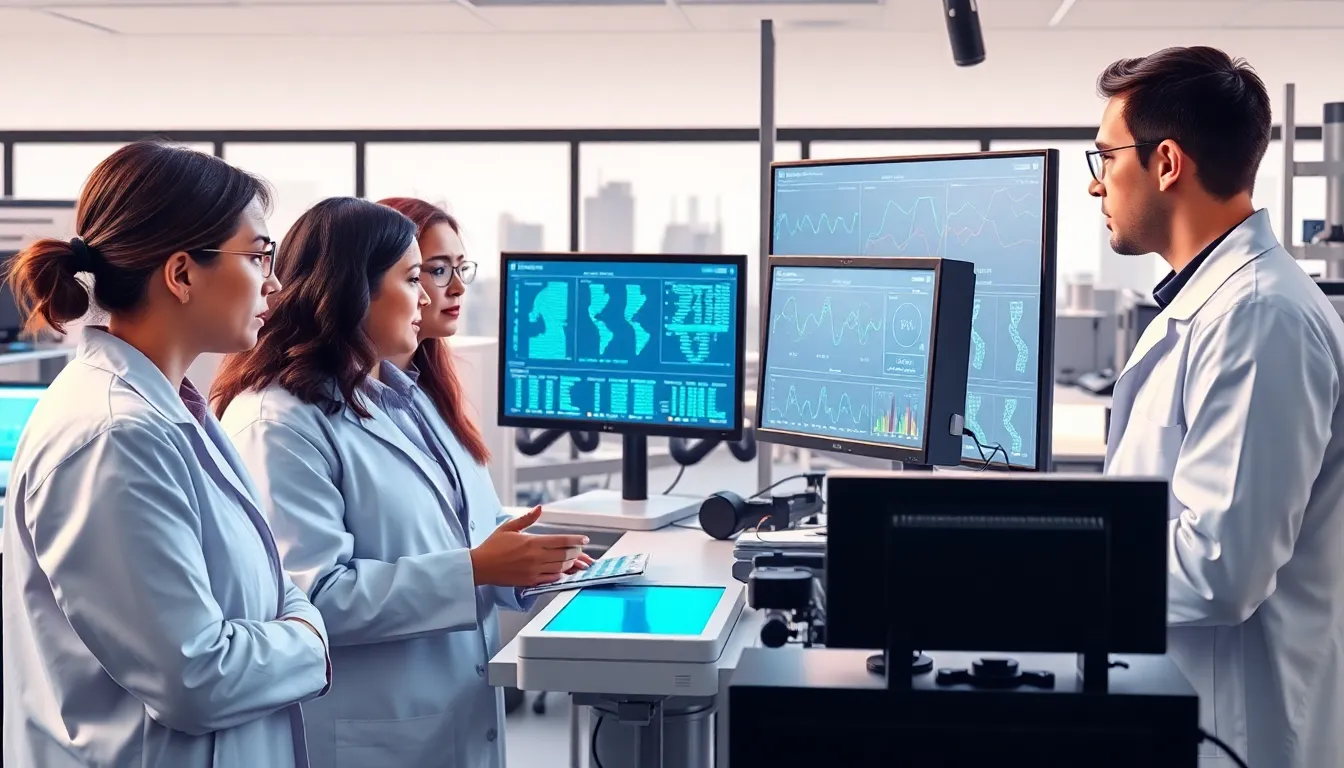In a world where science fiction often feels like reality, life sciences are riding the wave of technological innovation like a surfer on a perfect swell. From gene editing to artificial intelligence, the latest trends are transforming how researchers tackle everything from drug development to personalized medicine. It’s not just about lab coats and beakers anymore; it’s about harnessing cutting-edge technology to unlock the secrets of life itself.
Table of Contents
ToggleOverview of Technology Trends in Life Sciences
Technological advancements play a crucial role in transforming the landscape of life sciences. Artificial intelligence enhances data analysis, facilitating more accurate predictions in drug discovery. Machine learning algorithms identify patterns in clinical data, streamlining research processes significantly.
Genomic technologies drive personalized medicine, allowing tailored treatments based on individual genetic profiles. CRISPR and other gene-editing tools enable precise modifications at the DNA level, offering hope for previously untreatable conditions. Biotechnology innovations support vaccine development, speeding up responses to emerging health threats.
Data sharing platforms improve collaboration among researchers, fostering a global approach to tackling health challenges. Cloud computing enables storage and processing of vast amounts of biological data, enhancing collaboration and scalability.
Telemedicine technology expands access to healthcare services, allowing remote consultations and monitoring. Wearable devices collect real-time patient data, empowering individuals to manage their health proactively. Digital health solutions offer mobile applications for tracking wellness, encouraging healthy lifestyle choices.
Regulatory bodies increasingly embrace tech solutions for monitoring and ensuring compliance within the industry. Blockchain technology improves transparency in supply chains, securing integrity in pharmaceutical distribution. Cybersecurity measures protect sensitive research data, addressing rising concerns over data breaches.
Emerging technologies, including robotics, automate laboratory processes, improving efficiency and accuracy. Integrating these innovations into life sciences is essential for staying ahead in a rapidly evolving field.
Impact of Artificial Intelligence

Artificial intelligence significantly transforms life sciences, enhancing efficiency and precision in various applications. The integration of AI technologies revolutionizes data analysis and accelerates innovations across the sector.
Machine Learning Applications
Machine learning algorithms automate data processing in clinical trials. These algorithms identify patterns in complex datasets, streamlining drug discovery processes. Researchers frequently utilize predictive analytics to forecast outcomes and improve treatment efficacy. By analyzing vast genomic sequences, machine learning provides insights into disease mechanisms. This capability leads to the development of personalized therapies that cater to individual genetic profiles.
Natural Language Processing
Natural language processing serves as a powerful tool in life sciences research. It enables the extraction of valuable information from unstructured data sources, such as scientific literature and clinical reports. Researchers utilize NLP to summarize findings and identify relevant studies, thus expediting the research process. Enhanced communication with stakeholders occurs through automated report generation and data visualization. Additionally, NLP applications help analyze patient feedback, which is crucial for improving healthcare delivery and outcomes.
Advances in Genomics
Advancements in genomics significantly shape personalized medicine and treatment options.
CRISPR Technology
CRISPR technology revolutionizes genetic editing, allowing precise modifications to DNA sequences. Researchers utilize this tool for developing therapies that target genetic disorders effectively. Enhanced accuracy and efficiency reduce off-target effects while improving patient outcomes. In clinical trials, CRISPR has demonstrated potential for correcting mutations linked to diseases like sickle cell anemia. This innovation drives the exploration of gene therapies and raises ethical considerations regarding its use in human genetics.
Sequencing Innovations
Sequencing innovations contribute to rapid developments in genomics. Next-generation sequencing (NGS) techniques enable the analysis of vast amounts of genetic data faster and more affordably. These advancements facilitate large-scale genomic studies, identifying genetic variants associated with diseases. Organizations apply sequencing to enhance diagnostics and personalize treatment strategies based on individual genetic profiles. Continuous improvements in sequencing technologies promise to uncover new insights into complex diseases, transforming the approach to healthcare and research.
Telemedicine and Remote Monitoring
Telemedicine expands healthcare access by facilitating remote consultations. Innovations in digital health enable patients to connect with healthcare providers from their homes, thereby reducing barriers to care.
Digital Health Platforms
Digital health platforms streamline patient interactions with healthcare systems. They combine telehealth capabilities with integrated electronic health records. By providing a centralized hub for communication, these platforms enhance coordination among providers and improve outcomes. A significant example is the use of mobile apps that allow patients to monitor conditions and share data instantly. Data validates these platforms by showing over 70% of patients report enhanced satisfaction.
Patient Engagement Tools
Patient engagement tools increase involvement in personal health management. Tools include mobile applications, reminders, and educational resources. By utilizing these tools, patients gain insights into treatment options and adherence strategies. Studies show that effective engagement tools can improve medication adherence rates, with reported increases of up to 30%. Continuous feedback mechanisms within these tools foster better communication between patients and providers, ultimately empowering patients in their health journey.
Data Analytics in Life Sciences
Data analytics plays a vital role in driving innovations within life sciences. By harnessing the vast amounts of data generated, researchers can derive valuable insights that aid in decision-making and improve patient outcomes.
Big Data Utilization
Big data utilization in life sciences enables organizations to analyze complex datasets for enhanced research and development. According to recent studies, nearly 80% of healthcare data remains unstructured, presenting challenges and opportunities for data scientists. Advanced analytical tools streamline the handling of this data, facilitating the identification of patterns and trends. Predictive modeling techniques uncover correlations that inform treatment protocols and patient care strategies. Additionally, the integration of big data with genomic information fosters personalized medicine approaches, thus aligning therapies with individual patient profiles. A traditional approach no longer suffices, while leveraging big data positions organizations at the forefront of innovation.
Predictive Analytics
Predictive analytics serves as a crucial component in advancing life sciences research and patient care. This technique uses historical data and machine learning algorithms to anticipate outcomes and improve clinical decision-making. For instance, predictive models can identify at-risk patients, allowing for proactive interventions that enhance health management. Metadata analysis has shown that these systems can increase the accuracy of predicting patient responses to therapies by over 20%. Furthermore, clinical trial optimization benefits significantly from predictive analytics, refining participant selection and improving retention rates. By anticipating adverse events and resource needs, organizations enhance operational efficiency and contribute to improved patient experiences.
The life sciences sector is undergoing a transformative journey fueled by technological advancements. Innovations like AI and genomic technologies are not just enhancing research methods but are also paving the way for personalized medicine and tailored therapies.
As these technologies continue to evolve they promise to improve patient outcomes and streamline healthcare processes. The integration of data analytics and telemedicine is empowering patients while fostering collaboration among researchers.
Embracing these trends is essential for organizations aiming to stay competitive in this rapidly changing landscape. The future of life sciences looks promising with technology leading the charge toward more effective and accessible healthcare solutions.





